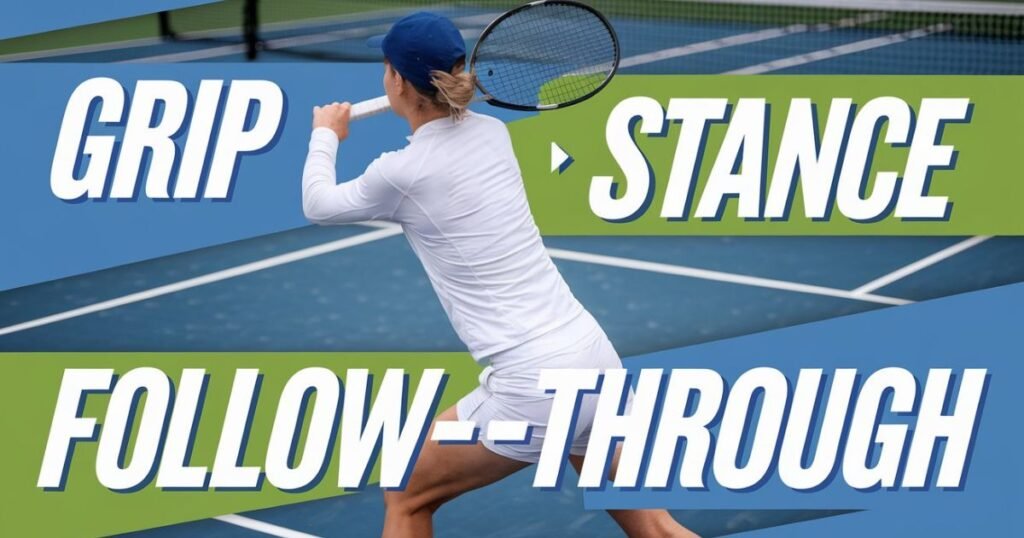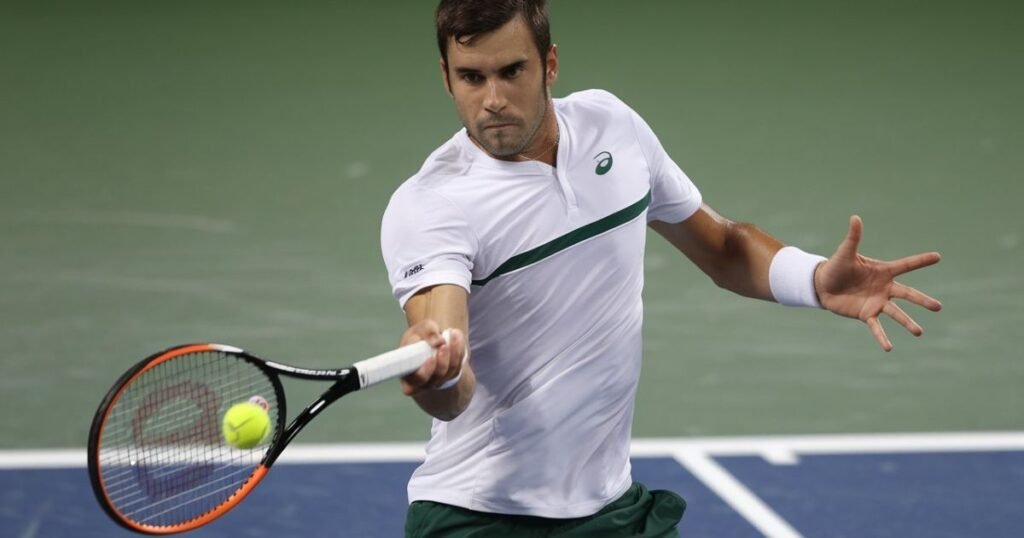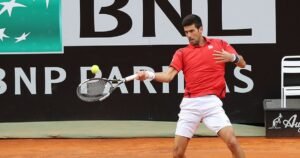Want to master one of tennis’s key shots? The forehand is essential for any player looking to improve and succeed on the court. In this easy-to-follow guide, How to Perfect Your Tennis Forehand: A Step-by-Step Guide, we break down everything you need to know to enhance your forehand. We’ll help you build a strong and reliable shot from the basics to advanced tips and drills. No matter your experience level.
This guide makes learning simple and effective. Get ready to transform your game with a forehand that can win any match!
Table of Contents
Understanding the Forehand
Before we get into the nitty-gritty of technique, let’s start with the basics. The forehand is a shot you make with the front of your racket hand facing the ball. It’s usually the most powerful and reliable shot in your arsenal.
Types of Forehands:
- Topspin Forehand: This shot generates a high bounce, making it easier to control.
- Flat Forehand: Known for its speed, but requires more precision.
- Slice Forehand: Adds a low, skidding bounce, which is useful for defensive plays.
Each type has its own benefits, and practicing them all will give you versatility on the court.
The Perfect Stance
Your stance is crucial for a strong and consistent forehand.
Open Stance:
- How to: Position your feet shoulder-width apart with your front foot slightly turned to the side.
- Pros: Great for quick adjustments and powerful shots.
Closed Stance:
- How to: Place your feet parallel to the baseline, turning your body more towards the net.
- Pros: Provides more control and balance, ideal for powerful shots.
Step-by-Step Setup:
- Position Your Feet: Stand shoulder-width apart.
- Turn Your Body: Rotate your shoulders and hips to face the net.
- Knees Slightly Bent: This will help with balance and power.
Grip Techniques

The grip you use can affect the quality of your shot.
Eastern Grip:
- How to: Place the base knuckle of your index finger on the third bevel of the racket handle.
- Benefits: Offers a good balance between power and control.
Semi-Western Grip:
- How to: Shift your hand slightly to the right on the handle (for right-handed players).
- Benefits: Helps generate more topspin.
Western Grip:
- How to: Rotate your hand so that the base knuckle is on the fourth bevel.
- Benefits: Ideal for heavy topspin shots.
Grip Drills:
- Shadow Swings: Practice the grip without hitting a ball.
- Grip Strengthening: Use grip trainers to improve hand strength.
The Forehand Swing Mechanics
Mastering the swing is key to a great forehand.
Backswing:
- How to: Bring your racket back with a relaxed arm and shoulder turn.
Contact Point:
- Where to Hit: Aim to meet the ball slightly in front of your body at waist height.
- Tip: Focus on hitting the center of the racket strings for a clean shot.
Follow-Through:
- How to: Extend your arm fully and finish with your racket high above your shoulder.
Common Mistakes:
- Hitting Late: Make sure to strike the ball before it passes your body.
- Over-Swinging: Keep your swing smooth and controlled.
Drills to Improve Your Forehand
Practicing is essential to mastering the forehand.
Solo Drills:
- Wall Hits: Rally against a wall to practice consistency.
- Shadow Swings: Work on your form without a ball.
Partner Drills:
- Forehand Rally: Practice with a partner, focusing on accuracy and power.
- Target Practice: Set up targets on the court and aim for them with your forehand.
On-Court Drills:
- High Ball Drills: Practice hitting high balls to improve your topspin.
- Cross-Court Rallies: Work on your ability to hit forehands from different angles.
Advanced Techniques for Tennis Forehand

Once you’re comfortable with the basics, try these advanced techniques.
Topspin Variations:
- How to: Use a brushing motion to generate topspin, which will make the ball bounce higher.
Power Shots:
- How to: Focus on explosive leg drive and a full follow-through to increase shot speed.
Consistency Training:
- How to: Regularly practice hitting with accuracy to build reliability in your forehand.
Video Analysis and Feedback
Analyzing your technique can provide valuable insights.
Using Technology:
- How to: Record your forehand shots and review them to spot areas for improvement.
Seeking Professional Help:
- When to: Consider getting feedback from a coach to refine your technique.
Self-Evaluation Tips:
- What to Look For: Check your stance, grip, and follow-through against standard techniques.
Common Problems and Solutions
Here are some common issues and how to fix them.
Top 5 Issues:
- Inconsistent Contact: Focus on hitting the ball in the right spot.
- Lack of Power: Work on your leg drive and follow-through.
- Misplaced Feet: Ensure your stance is correct and balanced.
- Timing Issues: Practice hitting the ball earlier in your swing.
- Poor Spin: Experiment with different grips and brushing techniques.
Injury Prevention:
- Tip: Warm up properly and avoid overuse to prevent injuries.
Mental Game:
- Tip: Stay focused and confident, even when you make mistakes.
Conclusion
Perfecting your tennis forehand takes time and practice, but with these tips and techniques, you’ll be on your way to a powerful and reliable shot. Remember to keep practicing and refining your skills, and you’ll see improvement on the court.
Share your progress with us in the comments or connect with a local tennis coach to take your game to the next level.
FAQs
What is a Forehand?
When you hit a tennis shot with your palm facing the ball, it’s known as a forehand. One of the most popular and effective strokes, it aids players in maintaining control of the game and making crucial shots. Depending on the circumstance, you can hit it flat, with a slice, or with topspin.
How to Hit a Forehand in Tennis?
To hit a forehand, stand sideways to the net with your racket ready. Swing from low to high, hitting the ball in front of you with a smooth motion. Follow through with your racket over your shoulder to add control and power to your shot.
How to Hit a Forehand with Topspin?
To hit a topspin forehand, use a semi-western or western grip. Swing from low to high, brushing up on the ball as you make contact. This upward motion creates spin, making the ball dip down after crossing the net. The more you brush up, the more spin you get.
How to generate more power in my forehand?
Work on your leg drive and follow-through. A full swing and strong base will help you hit with more power.
What is the best grip for a forehand?
The Eastern grip is ideal for beginners as it balances power and control. For more topspin, try the Semi-Western grip.
Who Has the Best Tennis Forehand?
Players like Roger Federer, Rafael Nadal, and Juan Martín del Potro are famous for their great forehands. Federer’s is known for its accuracy, Nadal’s for its heavy topspin, and del Potro’s for its power. Each player uses their forehand in unique ways to dominate the game.



Pingback: 10 Types of Tennis Shots Every Player Should Master
Pingback: Topspin Forehand Techniques: Add Power to Your Forehand
Pingback: Learn the basics of semi western grip in 5 simple steps